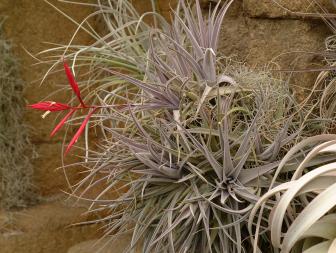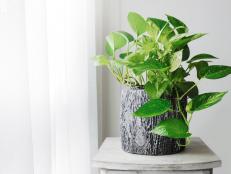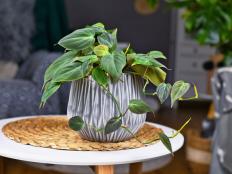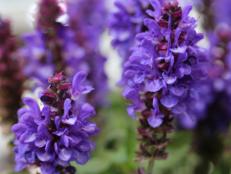How to Grow and Care for Air Plants
These quirky plants don’t need soil, but they can’t live on air alone. Here’s what you need to know to keep them healthy.

Paul T. Isley III / Rainforest Flora, Inc.

Air plants are adorable – more like pets than plants. No matter whether a variety is fuzzy, furry, spiky or trailing, it’s irresistible. Air plants are usually tiny, easy to grow, and they don’t need soil. As the name implies, air plants absorb nutrients and water from the air through scales on their leaves.
Air plants are having a moment as houseplants because they’re easy to care for and don’t need much light to thrive.
What Are Air Plants?
Air plants look as if they came from another planet, but they’re native to the Americas, ranging from the southern United States to Argentina. In the wild, they use their roots to hang on the bark of trees, feeding on rainwater and bird poop they absorb through their leaves. There are more than 600 species and varieties of air plants, also called Tillandsias.
12 Planter Ideas for Decorating With Air Plants 12 Photos
These little lovelies deserve a fabulous planter for being so wonderfully low-maintenance.
They usually have strap-like leaves that grow in a rosette pattern with new growth coming from the center of the plant. The foliage may be silver or green, spiky or fuzzy, and some produce flowers in shades of red, pink or purple that last from a few days to a few months. Most air plants are tiny, ranging from 2" to 12" tall.
Air plants are hard to identify because of the multitude of types and because two plants of the same species can look completely different depending on climate. The same species of air plant grown in California will look completely different than one grown in Florida.
Botanical Name: Tillandsia spp.
Common Name: Air Plants
Hardiness Zones: 9 to 13
Planting Air Plants
- Don’t plant them in dirt. Ever. They’re epiphytes, which means they grow on other plants, not in the ground.
- Because they don’t need dirt, you can put them in creative places. Place one in a shallow bowl or vase filled with rocks or sand, place one in a tiny container with a magnet and put it on the fridge, or tie them to driftwood with a translucent fishing line.
- Don’t put them in an enclosed terrarium. Yes, they look cute, and there are photos of terrariums of air plants all over Instagram, but air plants need the circulation of air. A closed vessel will keep them too wet, causing them to rot or get a fungal disease.
Air Plant Care
How to Water an Air Plant
Air plants have a rep for being easy to care for, and they are, if you play by their rules. The first rule of air plants is they cannot live on air alone. They need lots of water. But the second rule? Give them too much water and they’ll die.
Confusing, we know. But here’s the secret to watering air plants: Don’t mist them. Dunk them in water. Here’s how to take care of an air plant.
- Once a week, submerge air plants in water and let them sit there for hours.
- Use rainwater or bottled drinking water. Softened water is high in salts that will burn the air plants, and tap water has minerals that can clog the trichomes on air plant leaves and keep them from absorbing nutrients.
- Dry the air plants out. This is very important. After they soak, shake off excess water and put them in a bright spot for a couple of hours to dry.
- Feed them once a month by adding water-soluble fertilizer for epiphytes, bromeliads or air plants to the water you dunk them in. These specialized fertilizers contain nitrogen in a form they can absorb.
- Air plants like temperatures ranging between the 50s and 90s.
- They thrive with temperature fluctuations. Give them a 10-degree temperature drop that mimics cool nights in their native jungle and they’ll flourish.
- They cannot withstand a freeze. They’re totally tropical and need to come indoors for winter.
- Make sure they get at least 4 to 6 hours of bright, filtered light per day. They’ll love a room with lots of windows.
Blooms and Propagation of Air Plants
- Air plants may flower, but they bloom just once in their lifetime and then die.
- Get new air plants by harvesting their pups, the name for baby air plants. Just before an air plant blooms, it will reproduce by sending out pups from its base.
- Pull the pup from the mother plant when the baby is 1/3 to 1/2 the size of the parent plant.
Air Plant Pests and Diseases
- Look out for mealybugs and scale insects on air plants. If your plant gets an infestation, treat it with a Tillandsia-safe pesticide.
- Dampness is the enemy of air plants. Remember, the secret of air plant care is getting the water right. Too much moisture will cause a plant to rot from the inside out.
- Leaf rot or fungal diseases can also be a problem when air plants are too damp.
Recommended Air Plant Species
'Bulbosa' looks like a sea creature, with a bulb-shaped base and tentacle-like leaves. Varieties include ‘Guatemala’ and ‘Belize.’
'Inoantha,' also called a sky plant, has spiky leaves that start out silver-hued and turn a deeper shade of green as the plant matures. Native to Mexico and Costa Rica, it shoots out a striking yellow or white flower. Common varieties include ‘Guatemala,’ ‘Mexican’ and ‘Rubra.’
'Aeranthos' is native to Brazil, Paraguay and Argentina. This spiky little plant produces a pink bud that opens into a deep purple flower. Varieties include ‘Grey Ghost,’ ‘Bronze,’ ‘Black,’ and ‘Purple,’ after the colors of their leaves.
Air Plant Varieties 15 Photos
Discover the hidden beauty of exotic and easy to care for air plants.
'Streptophylla,' also know as Shirley Temple for its curly mane of leaves, likes drier conditions than other air plants.
'Latifolia' is one of the largest air plants, a spiky plant that grows up to 18 inches tall. It produces a tall, red bloom spike.
'Xerographica,' known as Xeros, are everyone’s favorite. These natives of Mexico have silver leaves that curl and spiral around themselves as they grow.
Garden Design Suggestions for Air Plants
- Indoors, put air plants near a window facing east, south or west.
- A sunny bathroom is an ideal spot for an air plant because it can get adequate light and drink in the humidity produced by daily showers.
- Outdoors, put air plants on a screened porch, lanai or pool enclosure so they can get the filtered sunlight they crave.
















































